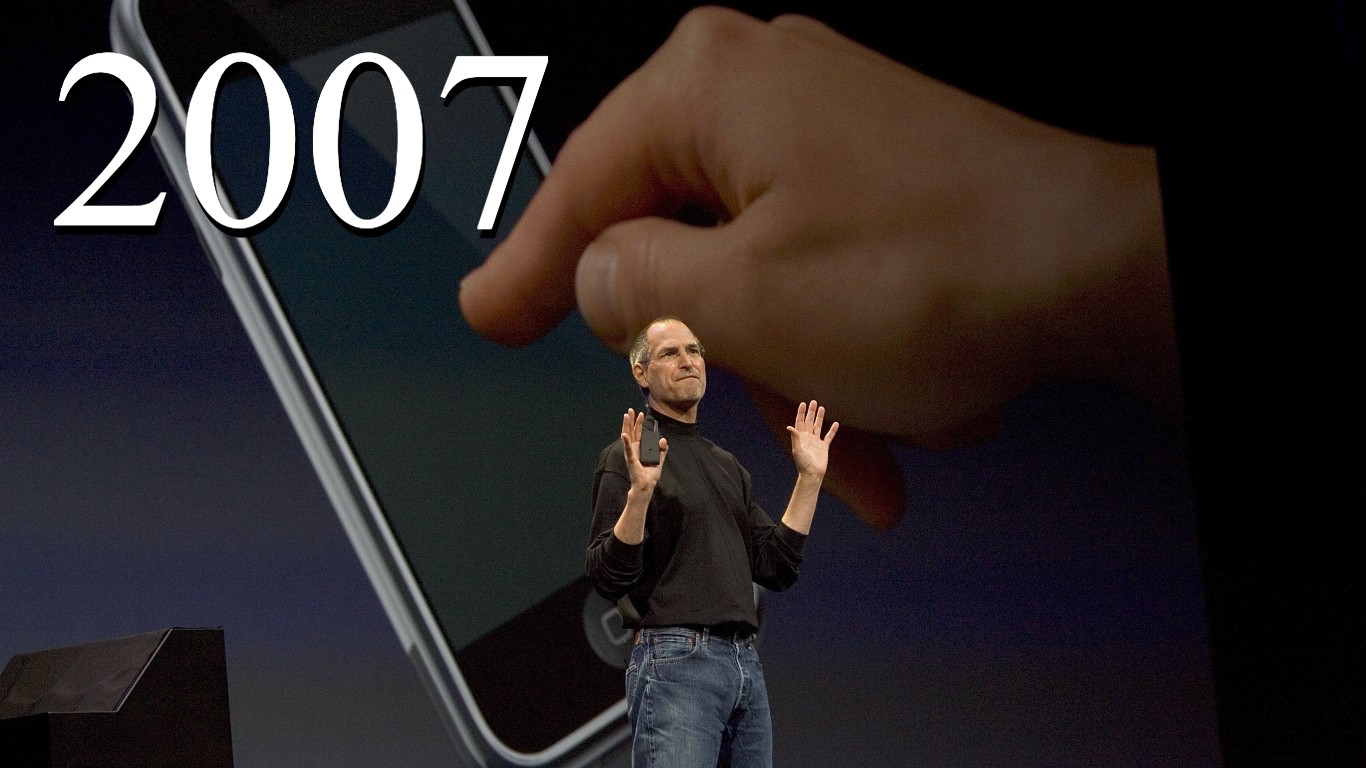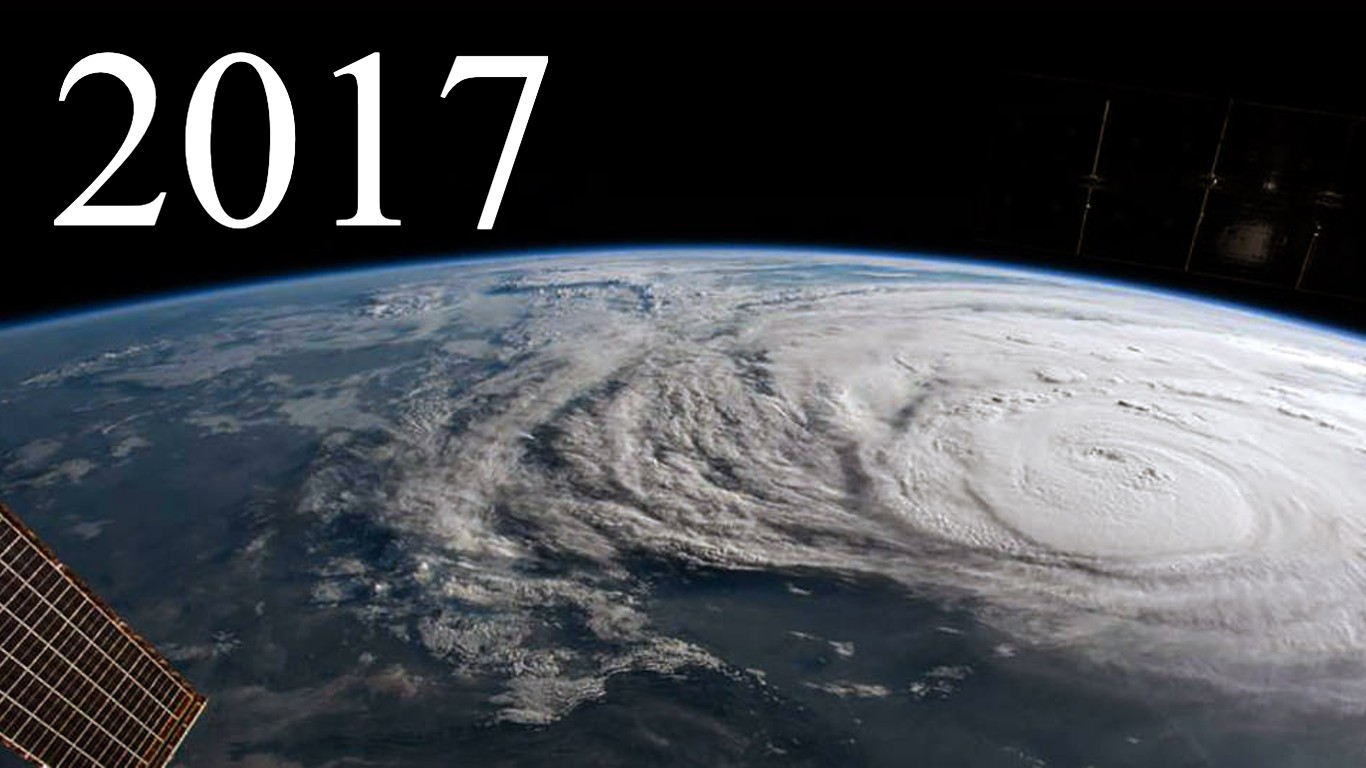
The American consumer’s mantra for ages has been to “Charge it!” Purchasing with plastic keeps the flow of goods and services moving, and the economy humming. But in the past four decades, Americans have relied more and more on their credit cards.
To determine how America’s credit card debt has changed since 1986, 24/7 Wall St. reviewed online personal finance site WalletHub’s 2023 Credit Card Debt Study. From the report, we listed the total outstanding credit card debt each year since 1986 and how much it changed compared to the previous year. All data included in the story is from WalletHub’s report. Charge-offs are the total value of accounts that a creditor writes off as a loss because it believes it will likely not be able to collect due to borrower delinquency, bankruptcy, or other reasons.
WalletHub’s study is based on data from TransUnion, the Federal Reserve, and Bureau of Labor Statistics. Outstanding debt amounts are adjusted for inflation with data from the Bureau of Labor Statistics. It should be noted that fourth quarter 2022 data is not yet available, and so 2022 data is for the first three quarters of the year.
Through the first three quarters of 2022, total outstanding credit card balances hit over $1 trillion, the highest since 1986 and not yet accounting for the full year. Last year also recorded the second largest jump in outstanding credit card debt in 37 years, with an increase of $79.2 billion by the third quarter. (Another form of debt is student loans. Here are states with the most past due student debt.)
Much of the spike in credit card debt could be attributed to the economic fallout from the COVID-19 pandemic. Consumers tend to use credit cards when the economy slumps and employment drops, as they did during the Great Recession of 2007 to 2009. During both 2007 and 2008, total outstanding credit card balances added up to nearly a trillion dollars – the seventh and sixth most, respectively, since 1986. Inflation may also be behind the rise in credit card usage.
WalletHub estimates the average credit card debt per household reached $9,260 in the second quarter of last year, 6.4% more than in the second quarter of 2021. Yet that number is $2,745 below what WalletHub projects as a breaking point for household finances. (See the states with the most credit card debt.)

1986
> Total outstanding credit card debt: $145.9 billion — #37 most since 1986
> Change in outstanding credit card debt: +$17.9 billion — #27 largest increase since 1986
> Credit card charge-off: $4.4 billion — #37 most since 1986
> Net result in debt load: +$22.3 billion — #34 largest increase since 1986
[in-text-ad]

1987
> Total outstanding credit card debt: $166.2 billion — #36 most since 1986
> Change in outstanding credit card debt: +$20.3 billion — #26 largest increase since 1986
> Credit card charge-off: $5.0 billion — #36 most since 1986
> Net result in debt load: +$25.3 billion — #33 largest increase since 1986

1988
> Total outstanding credit card debt: $190.6 billion — #35 most since 1986
> Change in outstanding credit card debt: +$24.4 billion — #25 largest increase since 1986
> Credit card charge-off: $5.5 billion — #35 most since 1986
> Net result in debt load: +$29.8 billion — #31 largest increase since 1986

1989
> Total outstanding credit card debt: $217.8 billion — #34 most since 1986
> Change in outstanding credit card debt: +$27.2 billion — #23 largest increase since 1986
> Credit card charge-off: $6.2 billion — #34 most since 1986
> Net result in debt load: +$33.5 billion — #29 largest increase since 1986
[in-text-ad-2]

1990
> Total outstanding credit card debt: $245.9 billion — #33 most since 1986
> Change in outstanding credit card debt: +$28.1 billion — #22 largest increase since 1986
> Credit card charge-off: $7.8 billion — #33 most since 1986
> Net result in debt load: +$35.8 billion — #27 largest increase since 1986

1991
> Total outstanding credit card debt: $271.5 billion — #32 most since 1986
> Change in outstanding credit card debt: +$25.6 billion — #24 largest increase since 1986
> Credit card charge-off: $11.5 billion — #30 most since 1986
> Net result in debt load: +$37.1 billion — #26 largest increase since 1986
[in-text-ad]

1992
> Total outstanding credit card debt: $286.4 billion — #31 most since 1986
> Change in outstanding credit card debt: +$14.9 billion — #29 largest increase since 1986
> Credit card charge-off: $12.4 billion — #29 most since 1986
> Net result in debt load: +$27.3 billion — #32 largest increase since 1986

1993
> Total outstanding credit card debt: $318.5 billion — #30 most since 1986
> Change in outstanding credit card debt: +$32.1 billion — #18 largest increase since 1986
> Credit card charge-off: $11.0 billion — #31 most since 1986
> Net result in debt load: +$43.1 billion — #24 largest increase since 1986

1994
> Total outstanding credit card debt: $375.5 billion — #29 most since 1986
> Change in outstanding credit card debt: +$57.0 billion — #9 largest increase since 1986
> Credit card charge-off: $10.4 billion — #32 most since 1986
> Net result in debt load: +$67.5 billion — #17 largest increase since 1986
[in-text-ad-2]

1995
> Total outstanding credit card debt: $455.6 billion — #28 most since 1986
> Change in outstanding credit card debt: +$80.1 billion — #1 largest increase since 1986
> Credit card charge-off: $14.3 billion — #28 most since 1986
> Net result in debt load: +$94.4 billion — #4 largest increase since 1986

1996
> Total outstanding credit card debt: $513.9 billion — #27 most since 1986
> Change in outstanding credit card debt: +$58.3 billion — #8 largest increase since 1986
> Credit card charge-off: $21.1 billion — #25 most since 1986
> Net result in debt load: +$79.4 billion — #10 largest increase since 1986
[in-text-ad]

1997
> Total outstanding credit card debt: $544.4 billion — #26 most since 1986
> Change in outstanding credit card debt: +$30.5 billion — #20 largest increase since 1986
> Credit card charge-off: $27.3 billion — #21 most since 1986
> Net result in debt load: +$57.8 billion — #20 largest increase since 1986

1998
> Total outstanding credit card debt: $585.7 billion — #25 most since 1986
> Change in outstanding credit card debt: +$41.3 billion — #11 largest increase since 1986
> Credit card charge-off: $28.8 billion — #17 most since 1986
> Net result in debt load: +$70.1 billion — #15 largest increase since 1986

1999
> Total outstanding credit card debt: $614.9 billion — #24 most since 1986
> Change in outstanding credit card debt: +$29.2 billion — #21 largest increase since 1986
> Credit card charge-off: $26.8 billion — #22 most since 1986
> Net result in debt load: +$56.0 billion — #22 largest increase since 1986
[in-text-ad-2]

2000
> Total outstanding credit card debt: $688.2 billion — #23 most since 1986
> Change in outstanding credit card debt: +$73.3 billion — #4 largest increase since 1986
> Credit card charge-off: $27.5 billion — #20 most since 1986
> Net result in debt load: +$100.8 billion — #2 largest increase since 1986

2001
> Total outstanding credit card debt: $720.4 billion — #22 most since 1986
> Change in outstanding credit card debt: +$32.2 billion — #17 largest increase since 1986
> Credit card charge-off: $37.7 billion — #10 most since 1986
> Net result in debt load: +$69.9 billion — #16 largest increase since 1986
[in-text-ad]

2002
> Total outstanding credit card debt: $756.7 billion — #21 most since 1986
> Change in outstanding credit card debt: +$36.3 billion — #13 largest increase since 1986
> Credit card charge-off: $46.2 billion — #4 most since 1986
> Net result in debt load: +$82.5 billion — #9 largest increase since 1986

2003
> Total outstanding credit card debt: $774.6 billion — #20 most since 1986
> Change in outstanding credit card debt: +$17.9 billion — #27 largest increase since 1986
> Credit card charge-off: $43.8 billion — #6 most since 1986
> Net result in debt load: +$61.7 billion — #18 largest increase since 1986

2004
> Total outstanding credit card debt: $807.9 billion — #19 most since 1986
> Change in outstanding credit card debt: +$33.3 billion — #15 largest increase since 1986
> Credit card charge-off: $38.4 billion — #8 most since 1986
> Net result in debt load: +$71.7 billion — #13 largest increase since 1986
[in-text-ad-2]
2005
> Total outstanding credit card debt: $839.5 billion — #14 most since 1986
> Change in outstanding credit card debt: +$31.6 billion — #19 largest increase since 1986
> Credit card charge-off: $38.9 billion — #7 most since 1986
> Net result in debt load: +$70.6 billion — #14 largest increase since 1986

2006
> Total outstanding credit card debt: $905.4 billion — #10 most since 1986
> Change in outstanding credit card debt: +$65.9 billion — #5 largest increase since 1986
> Credit card charge-off: $30.3 billion — #16 most since 1986
> Net result in debt load: +$96.2 billion — #3 largest increase since 1986
[in-text-ad]

2007
> Total outstanding credit card debt: $981.6 billion — #7 most since 1986
> Change in outstanding credit card debt: +$76.2 billion — #3 largest increase since 1986
> Credit card charge-off: $36.7 billion — #11 most since 1986
> Net result in debt load: +$112.8 billion — #1 largest increase since 1986

2008
> Total outstanding credit card debt: $983.9 billion — #6 most since 1986
> Change in outstanding credit card debt: +$2.3 billion — #32 largest increase since 1986
> Credit card charge-off: $53.8 billion — #3 most since 1986
> Net result in debt load: +$56.2 billion — #21 largest increase since 1986

2009
> Total outstanding credit card debt: $897.8 billion — #11 most since 1986
> Change in outstanding credit card debt: -$86.1 billion — #2 largest decrease since 1986
> Credit card charge-off: $85.3 billion — #1 most since 1986
> Net result in debt load: -$0.9 billion — #2 largest decrease since 1986
[in-text-ad-2]

2010
> Total outstanding credit card debt: $822.3 billion — #18 most since 1986
> Change in outstanding credit card debt: -$75.5 billion — #3 largest decrease since 1986
> Credit card charge-off: $77.8 billion — #2 most since 1986
> Net result in debt load: +$2.3 billion — #35 largest increase since 1986

2011
> Total outstanding credit card debt: $823.4 billion — #16 most since 1986
> Change in outstanding credit card debt: +$1.1 billion — #33 largest increase since 1986
> Credit card charge-off: $44.9 billion — #5 most since 1986
> Net result in debt load: +$45.9 billion — #23 largest increase since 1986
[in-text-ad]

2012
> Total outstanding credit card debt: $823.2 billion — #17 most since 1986
> Change in outstanding credit card debt: -$0.2 billion — #4 largest decrease since 1986
> Credit card charge-off: $31.7 billion — #15 most since 1986
> Net result in debt load: +$31.5 billion — #30 largest increase since 1986

2013
> Total outstanding credit card debt: $837.1 billion — #15 most since 1986
> Change in outstanding credit card debt: +$13.9 billion — #30 largest increase since 1986
> Credit card charge-off: $28.0 billion — #18 most since 1986
> Net result in debt load: +$41.8 billion — #25 largest increase since 1986

2014
> Total outstanding credit card debt: $869.6 billion — #13 most since 1986
> Change in outstanding credit card debt: +$32.5 billion — #16 largest increase since 1986
> Credit card charge-off: $26.2 billion — #23 most since 1986
> Net result in debt load: +$58.7 billion — #19 largest increase since 1986
[in-text-ad-2]

2015
> Total outstanding credit card debt: $880.1 billion — #12 most since 1986
> Change in outstanding credit card debt: +$10.5 billion — #31 largest increase since 1986
> Credit card charge-off: $25.0 billion — #24 most since 1986
> Net result in debt load: +$35.4 billion — #28 largest increase since 1986

2016
> Total outstanding credit card debt: $940.9 billion — #9 most since 1986
> Change in outstanding credit card debt: +$60.8 billion — #7 largest increase since 1986
> Credit card charge-off: $28.0 billion — #18 most since 1986
> Net result in debt load: +$88.8 billion — #7 largest increase since 1986
[in-text-ad]

2017
> Total outstanding credit card debt: $996.5 billion — #5 most since 1986
> Change in outstanding credit card debt: +$55.6 billion — #10 largest increase since 1986
> Credit card charge-off: $33.4 billion — #13 most since 1986
> Net result in debt load: +$89.0 billion — #6 largest increase since 1986

2018
> Total outstanding credit card debt: $1,032.8 billion — #3 most since 1986
> Change in outstanding credit card debt: +$36.3 billion — #13 largest increase since 1986
> Credit card charge-off: $35.8 billion — #12 most since 1986
> Net result in debt load: +$72.1 billion — #12 largest increase since 1986

2019
> Total outstanding credit card debt: $1,070.1 billion — #2 most since 1986
> Change in outstanding credit card debt: +$37.3 billion — #12 largest increase since 1986
> Credit card charge-off: $37.8 billion — #9 most since 1986
> Net result in debt load: +$75.2 billion — #11 largest increase since 1986
[in-text-ad-2]

2020
> Total outstanding credit card debt: $955.1 billion — #8 most since 1986
> Change in outstanding credit card debt: -$115.0 billion — #1 largest decrease since 1986
> Credit card charge-off: $33.0 billion — #14 most since 1986
> Net result in debt load: -$82.1 billion — #1 largest decrease since 1986

2021
> Total outstanding credit card debt: $1,020.9 billion — #4 most since 1986
> Change in outstanding credit card debt: +$65.8 billion — #6 largest increase since 1986
> Credit card charge-off: $20.5 billion — #26 most since 1986
> Net result in debt load: +$86.2 billion — #8 largest increase since 1986
[in-text-ad]

2022 (through Q3)
> Total outstanding credit card debt: $1,100.1 billion– the most since 1986
> Change in outstanding credit card debt: +$79.2 billion — #2 largest increase since 1986
> Credit card charge-off: $15.1 billion– #27 most since 1986
> Net result in debt load: +$94.4 billion– #4 largest increase since 1986
It’s Your Money, Your Future—Own It (sponsor)
Are you ahead, or behind on retirement? For families with more than $500,000 saved for retirement, finding a financial advisor who puts your interest first can be the difference, and today it’s easier than ever. SmartAsset’s free tool matches you with up to three fiduciary financial advisors who serve your area in minutes. Each advisor has been carefully vetted and must act in your best interests. Start your search now.
If you’ve saved and built a substantial nest egg for you and your family, don’t delay; get started right here and help your retirement dreams become a retirement reality.
Thank you for reading! Have some feedback for us?
Contact the 24/7 Wall St. editorial team.
 24/7 Wall St.
24/7 Wall St.
 24/7 Wall St.
24/7 Wall St. 24/7 Wall St.
24/7 Wall St.

